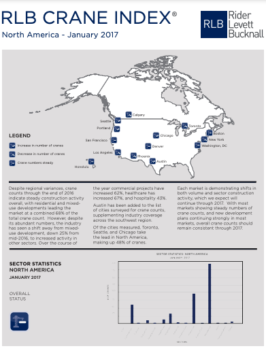According to the January 2017 issue of the North American Crane Index®, residential high-rise construction continues to tower above all other sectors, including mixed-use projects. Of the cities included in the report, high-rise residential and mixed-used developments comprise about 68 percent of total construction activity. In the second half of 2016, mixed-use construction declined by almost 25 percent, while commercial, healthcare, and hospitality sectors all experienced significant growth.
“Construction activity remains steady throughout the North American cities included in Crane Index. High-rise residential projects maintain a significant lead over other sectors.” notes Julian Anderson, president of Rider Levett Bucknall North America. “Our research indicates that new projects are scheduled to commence in most cities as existing projects are completed. We therefore anticipate that cumulative activity in all sectors will remain consistent.”
Each market is demonstrating shifts in both volume and sector construction activity, which we expect will continue through 2017.
Despite regional variances, crane counts through the end of 2016 indicate steady construction activity. With most markets showing steady numbers of crane counts, and new development plans continuing strongly in most markets, overall crane counts should remain consistent through 2017.
The bulk of construction projects in the markets surveyed took place in Toronto, Seattle, and Chicago. These cities employed 48 percent of all cranes counted. Each of these markets experienced significant high-rise residential construction.
About the North American RLB Crane Index
Rider Levett Bucknall’s North American RLB Crane Index® is published biannually and currently tracks the number of cranes in use in 14 major cities across the U.S. and Canada. Unlike other industry barometers that track cost and other financial data, the Crane Index tracks the number of fixed cranes on construction sites and gives a simplified measure of the current state of the construction industry’s workload in each location. Index cities include Austin, Boston, Calgary, Chicago, Denver, Honolulu, Los Angeles, New York, Phoenix, Portland, San Francisco, Seattle, Toronto, and Washington, D.C.
FURTHER INFORMATION:



